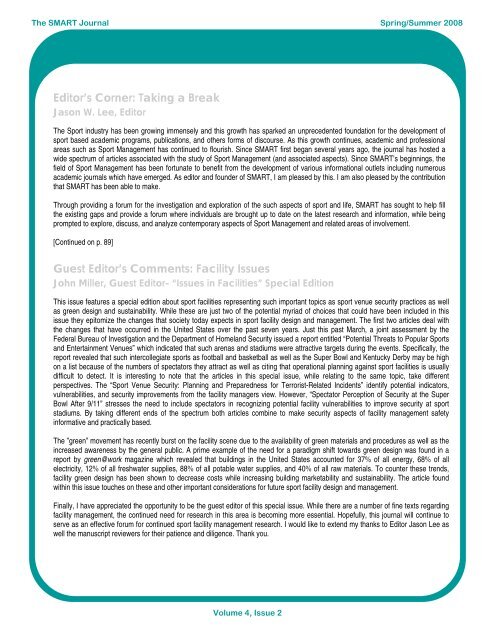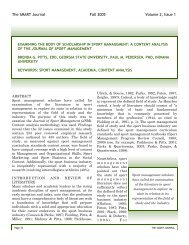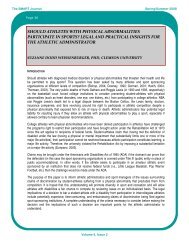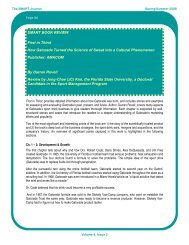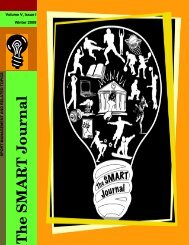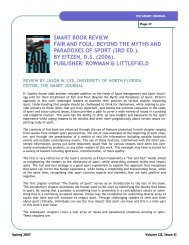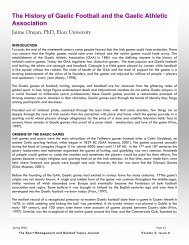Spring/Summer 2008 Volume 4, Issue 2 - The SMART Journal
Spring/Summer 2008 Volume 4, Issue 2 - The SMART Journal
Spring/Summer 2008 Volume 4, Issue 2 - The SMART Journal
Create successful ePaper yourself
Turn your PDF publications into a flip-book with our unique Google optimized e-Paper software.
<strong>The</strong> <strong>SMART</strong> <strong>Journal</strong> <strong>Spring</strong>/<strong>Summer</strong> <strong>2008</strong><br />
Page 5<br />
Editor’s Corner: Taking a Break<br />
Jason W. Lee, Editor<br />
<strong>The</strong> Sport industry has been growing immensely and this growth has sparked an unprecedented foundation for the development of<br />
sport based academic programs, publications, and others forms of discourse. As this growth continues, academic and professional<br />
areas such as Sport Management has continued to flourish. Since <strong>SMART</strong> first began several years ago, the journal has hosted a<br />
wide spectrum of articles associated with the study of Sport Management (and associated aspects). Since <strong>SMART</strong>’s beginnings, the<br />
field of Sport Management has been fortunate to benefit from the development of various informational outlets including numerous<br />
academic journals which have emerged. As editor and founder of <strong>SMART</strong>, I am pleased by this. I am also pleased by the contribution<br />
that <strong>SMART</strong> has been able to make.<br />
Through providing a forum for the investigation and exploration of the such aspects of sport and life, <strong>SMART</strong> has sought to help fill<br />
the existing gaps and provide a forum where individuals are brought up to date on the latest research and information, while being<br />
prompted to explore, discuss, and analyze contemporary aspects of Sport Management and related areas of involvement.<br />
[Continued on p. 89]<br />
Guest Editor’s Comments: Facility <strong>Issue</strong>s<br />
John Miller, Guest Editor- “<strong>Issue</strong>s in Facilities” Special Edition<br />
This issue features a special edition about sport facilities representing such important topics as sport venue security practices as well<br />
as green design and sustainability. While these are just two of the potential myriad of choices that could have been included in this<br />
issue they epitomize the changes that society today expects in sport facility design and management. <strong>The</strong> first two articles deal with<br />
the changes that have occurred in the United States over the past seven years. Just this past March, a joint assessment by the<br />
Federal Bureau of Investigation and the Department of Homeland Security issued a report entitled “Potential Threats to Popular Sports<br />
and Entertainment Venues” which indicated that such arenas and stadiums were attractive targets during the events. Specifically, the<br />
report revealed that such intercollegiate sports as football and basketball as well as the Super Bowl and Kentucky Derby may be high<br />
on a list because of the numbers of spectators they attract as well as citing that operational planning against sport facilities is usually<br />
difficult to detect. It is interesting to note that the articles in this special issue, while relating to the same topic, take different<br />
perspectives. <strong>The</strong> “Sport Venue Security: Planning and Preparedness for Terrorist-Related Incidents” identify potential indicators,<br />
vulnerabilities, and security improvements from the facility managers view. However, “Spectator Perception of Security at the Super<br />
Bowl After 9/11” stresses the need to include spectators in recognizing potential facility vulnerabilities to improve security at sport<br />
stadiums. By taking different ends of the spectrum both articles combine to make security aspects of facility management safety<br />
informative and practically based.<br />
<strong>The</strong> ”green” movement has recently burst on the facility scene due to the availability of green materials and procedures as well as the<br />
increased awareness by the general public. A prime example of the need for a paradigm shift towards green design was found in a<br />
report by green@work magazine which revealed that buildings in the United States accounted for 37% of all energy, 68% of all<br />
electricity, 12% of all freshwater supplies, 88% of all potable water supplies, and 40% of all raw materials. To counter these trends,<br />
facility green design has been shown to decrease costs while increasing building marketability and sustainability. <strong>The</strong> article found<br />
within this issue touches on these and other important considerations for future sport facility design and management.<br />
Finally, I have appreciated the opportunity to be the guest editor of this special issue. While there are a number of fine texts regarding<br />
facility management, the continued need for research in this area is becoming more essential. Hopefully, this journal will continue to<br />
serve as an effective forum for continued sport facility management research. I would like to extend my thanks to Editor Jason Lee as<br />
well the manuscript reviewers for their patience and diligence. Thank you.<br />
<strong>Volume</strong> 4, <strong>Issue</strong> 2


